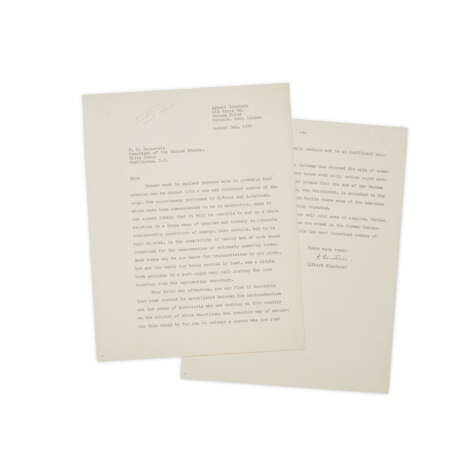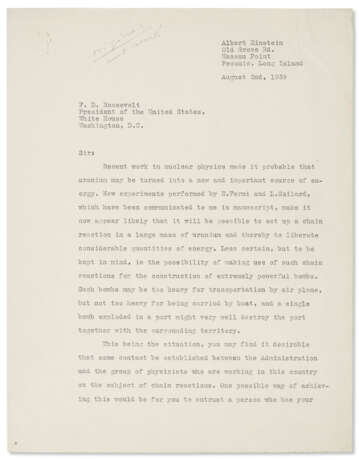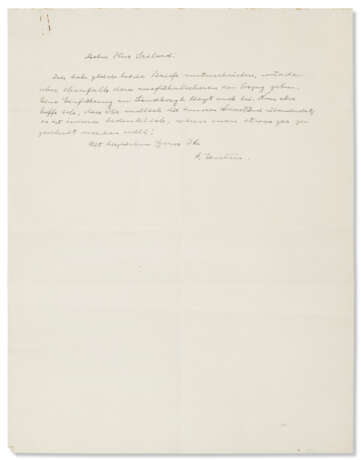ID 1279150
Лот 6 | WARNING F.D.R. OF GERMANY'S ABILITY TO DEVELOP THE ATOMIC BOMB
Оценочная стоимость
$ 4 000 000 – 6 000 000
ALBERT EINSTEIN, 2 AUGUST 1939
EINSTEIN, Albert (1879-1955). Typed letter signed ("A. Einstein") to President Franklin D. Roosevelt, Peconic, Long Island, 2 August 1939. [With:] EINSTEIN, Albert. Autograph letter signed ("A. Einstein") to Leo Szilard (1898-1964), [Peconic, Long Island, c. 4-7 August 1939].
Two pages on one side each of two sheets of typewriter bond paper, faint penciled note by Leo SZILARD (1898-1964) at top: "Original, not sent!". Letter of enclosure: in German. One page. [With:] a photograph of Einstein and Szilard reenacting the composition of the letter to FDR in 1946.
The dawn of the nuclear age. The alternative version of probably the most influential letter written in the twentieth century: Einstein's famous warning to Roosevelt of German efforts to effect a nuclear chain reaction with the potential for "the construction of extremely powerful bombs."
The atomic bomb, tested successfully at Alamogordo, New Mexico on 15 July 1945 and first used in warfare with chilling and awesome destructive effects less than a month later at Hiroshima (6 August), was the culmination of a massive and prolonged secret research project involving hundreds of American, British and European refugee scientists, engineers, and technicians. Its achievement decisively split human history into pre-atomic and atomic eras. The Manhattan Project was itself the outgrowth of a committee convened at the order of President Roosevelt in October 1939. Roosevelt's historic and momentous initiative was a direct response to a remarkable letter from the world's foremost theoretical physicist and an avowed pacifist; a man who, at that time, seemed a virtual personification of modern science: Albert Einstein.
This letter, reads in full:
"Recent work in nuclear physics made it probable that uranium may be turned into a new and important source of energy. New Experiments performed by E. Fermi and L. Szilard, which have been communicated to me in manuscript, make it now appear likely that it will be possible to set up a chain reaction in a large mass of uranium and thereby to liberate considerable quantities of energy. Less certain, but to be kept in mind, is the possibility of making use of such chain reactions for the construction of extremely powerful bombs. Such bombs may be too heavy for transportation by air plane, but not too heavy for being carried by boat, and a single bomb exploded in a port might very well destroy the port together with the surrounding territory."
"This being the situation, you may find it desirable that some contact be established between the Administration and the group of physicists who are working in this country on the subject of chain reactions. One possible way of achieving this would be for you to entrust a person who has your confidence, and who could perhaps act in an inofficial capacity, with this task. I understand that Germany has stopped the sale of uranium. That she should have taken such early action might perhaps be understood on the ground that the son of the German Under-Secretary of State, von Weizsäcker, is attached to the Kaiser-Wilhelm-Institut in Berlin where some of the American work on uranium is now being repeated. The United States has only poor ores of uranium. Better ores in moderate quantities are mined in the former Czechoslovakia and in Canada, while the most important source of uranium is Belgian Congo."
The impulse which led to the letter originated not with Einstein but with the Hungarian-born physicist Leo Szilard, a former student of Einstein's, who, like Fermi, Teller, Einstein and a host of other European scientists and researchers, had been driven from his homeland to the United States by the threat of Hitler's European aggression and persecution. In fact, the collaboration of Einstein and Szilard, motivated by their fears of German war preparations and nuclear research, generated not one, but two nearly identical letters, both typed on the same typewriter and both signed with the same pen by Einstein.
The present letter is based directly on the content that Einstein dictated in German. Leo Szilard then translated the text into English and dictated it in turn to a Columbia University typist. Unsure of the level of detail to present to the chief executive, Szilard also made a longer version that recommended specific administrative steps the President could take to support uranium research. The longer version was the one delivered to the White House. It has rested, since 1945, in the permanent collection of the Franklin D. Roosevelt Library at Hyde Park, New York and has been referenced in myriad histories and biographies. It is arguably the single-most influential letter of the twentieth century. Leo Szilard retained the original version of that historic communication and it is offered here, together with Einstein's handwritten letter to Szilard transmitting both signed letters addressed to the President of the United States.
Provenance
Leo S. Szilard (1898-1964).
Gertrud Weiss Szilard (1909-1981), wife of the preceding.
A relative of the above.
Anonymous sale; Christie's New York, 19 December 1986, lot 68.
Malcolm S. Forbes; Christie’s New York, 27 March 2002, lot 161.
Acquired at the above sale by the late owner.
| Категория аукционного дома: | Письма, документы и рукописи, Медицина и наука, Книги и рукописи |
|---|
| Категория аукционного дома: | Письма, документы и рукописи, Медицина и наука, Книги и рукописи |
|---|
| Адрес торгов |
CHRISTIE'S 8 King Street, St. James's SW1Y 6QT London Великобритания | |
|---|---|---|
| Предосмотр |
| |
| Телефон | +44 (0)20 7839 9060 | |
| Комиссия | see on Website | |
| Условия использования | Условия использования |






